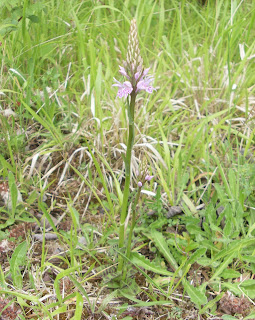ASHRIDGE ESTATE
As I was cycling up the B4506 I was very pleased to hear a total of 4 Cuckoos! However, the highlight was an intimate view of a TAWNY OWL perched on one of the national trust posts only metres from the road. My intention was to revisit the same site as on my previous visit in the hope of locating a roding Woodcock, however, on my arrival it was clearly too bright despite the ideal conditions. At least 70+ Roe Deer where also staring at me as I cycled past, whilst the bridleway produced the usual woodland residents including Great Spotted Woodpeckers and Green Woodpeckers.
IVINGHOE BEACON AND STEPS HILL
My next location was to walk the short section of the ridgeway leading to Ivinghoe Beacon. Around the car park and in the first field leading to Steps Hill there were 5 CORN BUNTINGS (a year tick). However, at the Beacon itself the scene was pure cloud and rain. I had originally hoped for some raptors but the conditions were clearly not suitable, instead I sat down and held out the rain scanning the surrounding fields. The rain still didn't deter the Skylarks from holding their territory and 2 Meadow Pipits doing a stand off, whilst several other farmland regulars also braved the conditions including singing Yellowhammers, Linnets, Chiffchaffs and Willow Warblers.
MARSWORTH AND STARTOP'S END RESERVOIR
It was still too early to visit College Lake as the reserve centre had still not opened so decided instead to make a brief visit to Marsworth and Stratop's End Reservoir were the highlight was a singing CETTI'S WARBLER in the Marsworth reedbed and audible from the causeway. It only emitted short bursts of song and at long time intervals, as is usual. Another bonus was a ♂ Cuckoo calling from the direction of the sewage farm before flying across the eastern edge of the reeds towards College Lake. Several Common Terns and hundreds of House Martins and Swifts, with lesser numbers of Swallows were also hawking over the water, mainly favouring Strartop's End Reservoir. I retraced my steps back to the northern corner of the Reservoir overlooking the reedbed. Unfortunately no Sedge Warblers yet but did see several Reed Warblers and Reed Buntings whilst the earlier Cuckoo had returned back to its favoured perch on the usual ash tree overlooking Marsworth Reservoir.
COLLEGE LAKE
I spent the longest time at College Lake as I haven't visited the site for some time and it currently boasts the widest expanse of marsh relative to all the other Reservoirs.
all five Dunlin
also feeding in the centre of the marsh
the ringed male Reed Bunting

the breeding Shelduck left with only 4 chicks from an original 11. The male refused to lift his head out of the water for a photo
Ringed Plover
the pair of Little Ringed Plover making their scrape

the breeding Shelduck left with only 4 chicks from an original 11. The male refused to lift his head out of the water for a photo
Ringed Plover
the pair of Little Ringed Plover making their scrape
male Cuckoo posing for the female
Cuckoo bizarrely with nest material, perhaps used for showing off to the nearby female
Several orchids were also starting to flower including what I think are Common Spotted Orchid and Narrow-leaved Helleborine, hopefully someone will confirm or correct me on my plant identification as I am still a total beginner on botany.
Common Spotted Orchid
possible Narrow-leaved Helleborine
Dingy Skipper
As I was passing the octagon hide going back to the visitor centre, I scanned the mud again to check the Dunlin and was surprised to see there were now seven birds. I returned back to the hide were I bumped into Geoff Lapworth (usual habitat: Stockers Lake and a local rarity at College Lake) and together IDed the new arrivals as 2 SANDERLING, my first inland record!
WILSTONE RESERVOIR
There was little prospect of finding anything unusual over by the hide as there was no muddy edge what so ever so I sat down at the end of the jetty watching the House Martins pelting around the reservoir. In fact they made so many close passes that I used my compact camera to film a few passing Martins. I was just marveling at the way they appear to avoid colliding with each other at such high densities and fast speed when two birds almost flew into each other, with both making a sharp bank away from each other making their alarm calls which I always bizarrely connect with the sound of farting (an unusual truth you didn't need to know)! Amongst the masses of House Martins were Swifts, occasional Swallows and 2 Sand Martins.
THE DRY CANAL
My last visit for the day was to the dry canal just south of Wilstone Reservoir in hope of finding Grey Partridges. Unfortunately very little about and no sign of any Partridges. However I was pleased to see a Brimstone butterfly perching and feeding from a thistle. The only birds of note were Whitethroats, Yellowhammers and a Red Kite over Miswell Farm.
A rather long days birding in all but relatively successful, given the fact I visited in June. I hope to make a similar visit directly after my exams later in the month but also revisit Marsworth reedbed at dusk to witness the roosting Corn Buntings and the prospect of a roding Woodcock.

























No comments:
Post a Comment